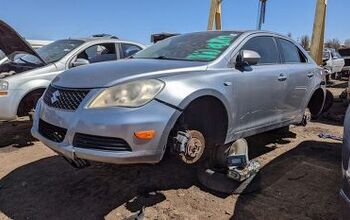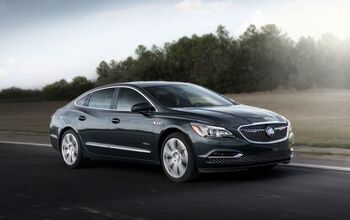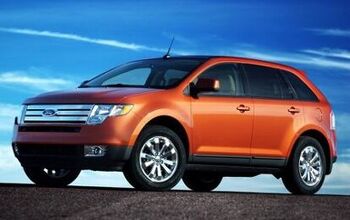Suzuki Death Watch 1: The Prologue

When the question of whether a Death Watch should be started for Suzuki was first posed here at TTAC in April, there was a lot going on behind the scenes at the stylized “S” brand but not many facts filtering out to the public.
As of today, TTAC’s Death Watch starts for Suzuki’s North American operations. And if you haven’t been following the drama, here’s some background for you…
Once an established niche brand making big deals with GM and high on success, American Suzuki has continually lost dealers since 2005, either due to dealers deciding to leave the brand or Suzuki offering $50,000 buyout packages for proprietors to wind down their operations. More than half of the remaining 246 dealers sell less than five new vehicles a month, which is not surprising considering Suzuki only has four models to choose from in the United States. In Canada, the Equator is no longer offered, so dealers north of the border must rely on the Grand Vitara, SX4, and Kizashi.
The changes aren’t just in the stores. In Brea, California, home of American Suzuki’s HQ, cost-cutting seems to have become the focus instead of a support exercise. Head of marketing, Steve Younan, left the company in January and no replacement has been hired to fill the role. Director of public relations, Jeff Holland, also quietly left Suzuki without a replacement announced. The company ended its agreement with J.D. Power and Associates for consumer satisfaction data with no replacement. Suzuki’s social media presence on Facebook has showed a couple signs of life recently, but the corporate Twitter account, @SuzukiAuto, has been disabled. As for future product, the biggest announcements have been refreshes to the SX4 and Grand Vitara, which are both getting on in years.
American Suzuki President Seiichi Maruyama and chairman Takashi Iwatsuki seem to be gutting the company, like some kind of automotive themed slasher flick.
On the other hand, global Suzuki operations have never been better. Maruti Suzuki in India enjoys significant success while the Suzuki Swift, not available in North America, receives repeated acclaim and accolades from the automotive press and car buying public.
So, is American Suzuki just winding down operations and finalizing their legal obligations before pulling the plug? Or is something larger at play in Brea? Only time will tell. But, it isn’t looking good, folks.

More by Mark Stevenson
Latest Car Reviews
Read moreLatest Product Reviews
Read moreRecent Comments
- Jalop1991 In a manner similar to PHEV being the correct answer, I declare RPVs to be the correct answer here.We're doing it with certain aircraft; why not with cars on the ground, using hardware and tools like Telsa's "FSD" or GM's "SuperCruise" as the base?Take the local Uber driver out of the car, and put him in a professional centralized environment from where he drives me around. The system and the individual car can have awareness as well as gates, but he's responsible for the driving.Put the tech into my car, and let me buy it as needed. I need someone else to drive me home; hit the button and voila, I've hired a driver for the moment. I don't want to drive 11 hours to my vacation spot; hire the remote pilot for that. When I get there, I have my car and he's still at his normal location, piloting cars for other people.The system would allow for driver rest period, like what's required for truckers, so I might end up with multiple people driving me to the coast. I don't care. And they don't have to be physically with me, therefore they can be way cheaper.Charge taxi-type per-mile rates. For long drives, offer per-trip rates. Offer subscriptions, including miles/hours. Whatever.(And for grins, dress the remote pilots all as Johnnie.)Start this out with big rigs. Take the trucker away from the long haul driving, and let him be there for emergencies and the short haul parts of the trip.And in a manner similar to PHEVs being discredited, I fully expect to be razzed for this brilliant idea (not unlike how Alan Kay wasn't recognized until many many years later for his Dynabook vision).
- B-BodyBuick84 Not afraid of AV's as I highly doubt they will ever be %100 viable for our roads. Stop-and-go downtown city or rush hour highway traffic? I can see that, but otherwise there's simply too many variables. Bad weather conditions, faded road lines or markings, reflective surfaces with glare, etc. There's also the issue of cultural norms. About a decade ago there was actually an online test called 'The Morality Machine' one could do online where you were in control of an AV and choose what action to take when a crash was inevitable. I think something like 2.5 million people across the world participated? For example, do you hit and most likely kill the elderly couple strolling across the crosswalk or crash the vehicle into a cement barrier and almost certainly cause the death of the vehicle occupants? What if it's a parent and child? In N. America 98% of people choose to hit the elderly couple and save themselves while in Asia, the exact opposite happened where 98% choose to hit the parent and child. Why? Cultural differences. Asia puts a lot of emphasis on respecting their elderly while N. America has a culture of 'save/ protect the children'. Are these AV's going to respect that culture? Is a VW Jetta or Buick Envision AV going to have different programming depending on whether it's sold in Canada or Taiwan? how's that going to effect legislation and legal battles when a crash inevitibly does happen? These are the true barriers to mass AV adoption, and in the 10 years since that test came out, there has been zero answers or progress on this matter. So no, I'm not afraid of AV's simply because with the exception of a few specific situations, most avenues are going to prove to be a dead-end for automakers.
- Mike Bradley Autonomous cars were developed in Silicon Valley. For new products there, the standard business plan is to put a barely-functioning product on the market right away and wait for the early-adopter customers to find the flaws. That's exactly what's happened. Detroit's plan is pretty much the opposite, but Detroit isn't developing this product. That's why dealers, for instance, haven't been trained in the cars.
- Dartman https://apnews.com/article/artificial-intelligence-fighter-jets-air-force-6a1100c96a73ca9b7f41cbd6a2753fdaAutonomous/Ai is here now. The question is implementation and acceptance.
- FreedMike If Dodge were smart - and I don't think they are - they'd spend their money refreshing and reworking the Durango (which I think is entering model year 3,221), versus going down the same "stuff 'em full of motor and give 'em cool new paint options" path. That's the approach they used with the Charger and Challenger, and both those models are dead. The Durango is still a strong product in a strong market; why not keep it fresher?


































Comments
Join the conversation
I didn't even know you could buy Suzukis in KC anymore. When I looked them up online, there's a dealer I've never heard of and the other one has spent more time in front of a judge than Matlock. Not good.
Just stumbled on this thread. The year is now 2020. Since 2005 have had a Suzuki Aerio SX in the driveway. That's 105 in dog years. It has never failed to start in all that time. Only thing I have replaced is vapor Cannister, which I ruined. It had it's problems (staticky radio, low riding 15" tires that hit everything left on the road and went bald after 20K miles) But it is peppy, turns on a dime, and, aside from a plastic body, is built like a tank.